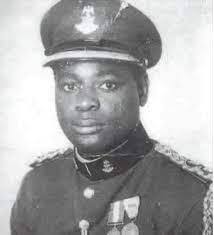Brigadier Zakariya Abubakar Hassan Maimalari was born on the 17th of January 1930 into the royal family of Maimalari, in Maimalari village of present-day Yobe State, Nigeria. At the tender age of four, he began his educational career at Nguru elementary school, also in present-day Yobe state.
Read more about Nigerians in history
He completed his primary education at Borno Middle School, Maiduguri in April 1941. From there, he proceeded to Barewa College Zaria, where he obtained the Cambridge School Certificate in December 1947.
Enlistment In The Nigerian Army
Maimalari and his childhood friend, Lawan Umar joined the Royal West Africa Frontier Force in 1950. As part of a Nigerianization program to enlist more Nigerians into the senior ranks of the army, he underwent a preparatory course at the Regular Officers Training School and proceeded to the West African School of Infantry in Teshi, Ghana about six months later. From Ghana, they proceeded for the United Kingdom and continued training first at Eaton Hall, Chester, on the 9th January 1951 and subsequently, the Royal Military Academy, Sandhurst. Both Maimalari and Lawan attended Sandhusrt but Lawan was later discharged from the army. Maimalari however, completed his course and e was eventually commissioned 2nd Lieutenant (Subaltern) on the 16th February 1953.
Rise Through The Ranks
Maimalari was the first Nigerian regular combatant commissioned into the Officer Corps of the Nigerian army. He was an instructor at the Nigerian Military Training College and later commander of the second battalion Nigerian army known as the Brigade, Apapa, Lagos in 1966.
This position, though a blessing, was also a curse for Maimalari. A blessing because the intention to promote more Nigerian officers led to an organizational structure developed by regional and ethnic considerations. A curse because the swift rise through the ranks from a regular combatant to an officer for Maimalari made Southern officers view him as a symbol of Northern domination.
Sign up to the Connect Nigeria daily newsletter
Courses And Responsibilities
As an officer in the Army, Maimalari attended many professional courses. They included:
- The Platoon Weapons Course at the school of Infantry, Hythe, England.
- The Regimental Signal Instructor’s Course at School of Infantry Signal Wing, in September 1956.
- The Platoon Commander’s course between 14th January and 24th March 1957 in England.
- The Company Commander’s course was also at the School of Infantry, England, between 14th June and 7th August 1959.
- In 1961 he was at the Staff College in Quetta, Pakistan.
- He also attended the Royal College of Defense Studies, London from January to December 1964.
Amidst the training, Maimalari held different positions and responsibilities. From 1957 – 1959, Zakariya Maimalari commanded the Officer Cadet training wing of what used to be known as the “Boys Company” in Zaria. Maimalari also served as second in command and instructor at the Nigerian Military Training College (N.M.T.C.) Jaji, Kaduna. He commanded the Second Battalion of the Nigerian Army in Abeokuta between 1962 – 1963 and finally rose as a Brigadier to command the Second Brigade, Nigerian Army, Apapa, Lagos from 1963 – 1966.
A Smoke In The Wind
The day prior to the 15 January 1966 coup, Maimalari was celebrating his recent marriage, unknowingly some of the attendees were also rebel leaders who would come back to haunt him. Later in the early hours of the following morning, some of the very officers who had warmly fraternized with others at the party that same evening returned to his house and attacked the Brigadier under the guise of staging a coup d’état.
On the day of the coup, as soon as rebel soldiers entered his compound, he escaped through the back of his house, at first hiding in small quarters in his compound before exiting into the main road. On the road, he flagged a car hoping to go to Ikeja, but unfortunately, the car was a rebel car and he was captured by his own Brigade Major and later killed.
Medals And Honour
Brigadier Zakariya Maimalari was the holder of the Campaign Stars Medal; Medal Forces Service Star; Queen Elizabeth the Second’s Coronation Medal and the United Nation’s Congo Medal.
Zakariya Maimalari and Lawan Umar, both of whom were from then Borno Province in what is today the northeast geo-political zone of Nigeria, were the first four (4) Africans, along with late King Hassan of Morocco and a Ghanaian Charles Buah, ever to attend and successfully pass out of the Royal Military Academy, Sandhurst (RMAS) in the United Kingdom.
Sources:
Gbulie, Ben (1981). Nigeria’s five majors: coup d’état of 15th January 1966 first inside account. Nigeria: Africana Educational Publishers
Saharareporters
Got a suggestion? Contact us: [email protected]

